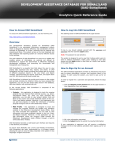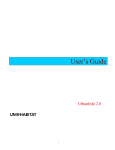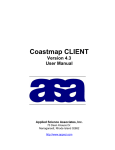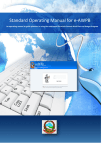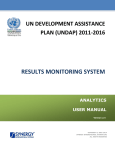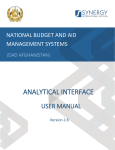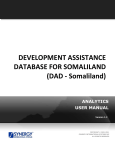Download DAD - Somaliland Analytics Training Manual
Transcript
DEVELOPMENT ASSISTANCE DATABASE FOR SOMALILAND (DAD - Somaliland) ANALYTICS TOT TRAINING MANUAL Version 1.0 12 AUG 2013 COPYRIGHT © 2001-2013 SYNERGY INTERNATIONAL SYSTEMS INC ALL RIGHTS RESERVED DAD SOMALILAND ANALYTICS TOT TRAINING MANUAL 1 TABLE OF CONTENTS 1. INTRODUCTION ......................................................................................................... 3 2. TRAINING MANUALS .................................................................................................. 4 2.1 ANALYTICS – LESSON 1 – MY PORTFOLIO .................................................................. 5 2.1.1 Accessing the My Portfolio Module ..................................................................... 5 2.1.2 Project Submission Workflow in the My Portfolio Module ....................................... 6 2.1.3 Actions Available in the My Portfolio Module ........................................................ 6 2.2 ANALYTICS – LESSON 2 – LIST ................................................................................. 7 2.2.1 Accessing the List Module ................................................................................. 7 2.2.2 Expanding the List Item ................................................................................... 7 2.2.3 Sorting List Items ............................................................................................ 8 2.2.4 Browsing among List Items ............................................................................... 8 2.2.5 Hiding / Showing Images in the List ................................................................... 8 2.2.6 Modifying the Current View ............................................................................... 9 2.3 ANALYTICS – LESSON 3 - CHART ............................................................................ 11 2.3.1 Accessing the Chart Module ............................................................................ 11 2.3.2 Chart Options ................................................................................................ 11 2.4 ANALYTICS – LESSON 4 - REPORT .......................................................................... 16 2.4.1 Accessing the Report Module ........................................................................... 16 2.4.2 Creating a Report .......................................................................................... 16 2.4.3 Previewing a Report ....................................................................................... 18 2.4.4 Generating a Report ....................................................................................... 19 2.4.5 Formatting/Styling Report Components ............................................................ 19 2.4.6 Re-ordering Report Table Components ............................................................. 22 2.4.7 Sorting Report Table Components .................................................................... 22 2.4.8 Removing a Report Table Component ............................................................... 23 2.4.9 Switching Report Table Components ................................................................ 23 2.5 ANALYTICS – LESSON 5 - CUSTOMIZED REPORTING ................................................. 24 2.5.1 Setting Report Options ................................................................................... 24 2.5.2 Saving Reports .............................................................................................. 24 2.5.3 Re-organising Reports .................................................................................... 25 2.5.4 Viewing Pre-defined Reports ........................................................................... 27 2.5.5 Editing Pre-defined Reports ............................................................................. 27 2.5.6 Exporting Reports .......................................................................................... 27 2.5.7 Printing Reports ............................................................................................ 28 2.6 ANALYTICS – LESSON 6 - FILTERING....................................................................... 29 2.6.1 Accessing the Filtering Section ........................................................................ 29 2.6.2 Creating Filtering Criteria ................................................................................ 29 2.7 ANALYTICS – LESSON 7 - SEARCH .......................................................................... 33 2.7.1 Accessing the Search Section .......................................................................... 33 2.7.2 Simple Search ............................................................................................... 33 2.7.3 Advanced Search ........................................................................................... 34 3. REFERENCES ............................................................................................................ 35 DAD SOMALILAND ANALYTICS TOT TRAINING MANUAL 2 TABLE OF FIGURES FIGURE 1: MY PORTFOLIO MODULE ............................................................................................... 5 FIGURE 2: MY PORTFOLIO TAB .................................................................................................... 5 FIGURE 3: CREATE NEW PROJECT BUTTON IN MY PORTFOLIO ................................................................ 6 FIGURE 4: LIST MODULE ........................................................................................................... 7 FIGURE 5: LIST TAB................................................................................................................. 7 FIGURE 6: EXPANDING THE LIST ITEM LEVEL .................................................................................... 8 FIGURE 7: HIDING IMAGES IN THE LIST .......................................................................................... 9 FIGURE 8: MODIFYING THE CURRENT VIEW ................................................................................... 10 FIGURE 9: CHART MODULE....................................................................................................... 11 FIGURE 10: CHART TAB .......................................................................................................... 11 FIGURE 11: MAIN SCREEN OF THE CHART MODULE .......................................................................... 12 FIGURE 12: VIEW SCREEN OF THE CHART MODULE .......................................................................... 13 FIGURE 13: UPDATE BUTTON IN CHART MODULE ............................................................................. 15 FIGURE 14: REPORT MODULE.................................................................................................... 16 FIGURE 15: REPORT TAB ......................................................................................................... 16 FIGURE 16: SELECTING A GROUPING FOR A REPORT ......................................................................... 17 FIGURE 17: COMPATIBILITY MATRIX............................................................................................ 18 FIGURE 18: PREVIEWING THE REPORT ......................................................................................... 19 FIGURE 19: REPORTS WINDOW WITH PROPERTIES FOCUS ON THE TITLE FIELD.......................................... 20 FIGURE 20: FORMATTING/STYLING TEXT ENTRIES ........................................................................... 20 FIGURE 21: REPORTS WINDOW WITH PROPERTIES FOCUS ON THE COLUMN .............................................. 21 FIGURE 22: ASSIGNING PROPERTIES TO REPORT TABLE COMPONENTS.................................................... 22 FIGURE 23: REORDERING REPORT TABLE COMPONENTS ..................................................................... 22 FIGURE 24: DEFINING THE SORTING ORDER .................................................................................. 23 FIGURE 25: SWITCHING REPORT TABLE COMPONENTS ...................................................................... 23 FIGURE 26: SETTING THE CHART REPORT OPTIONS .......................................................................... 24 FIGURE 27: MEMORIZING A REPORT............................................................................................ 25 FIGURE 28: ORGANIZING THE REPORTS ....................................................................................... 26 FIGURE 29: FILTERING SECTION ................................................................................................ 29 FIGURE 30: CREATING A FILTERING CRITERIA ................................................................................ 30 FIGURE 31: SEARCHING FOR A FILTERING CATEGORY ITEM ................................................................. 31 FIGURE 32: CREATING A SAMPLE FILTERING CRITERIA ...................................................................... 32 FIGURE 33: SEARCH SECTION ................................................................................................... 33 FIGURE 34: ADVANCED SEARCH SECTION ..................................................................................... 34 DAD SOMALILAND ANALYTICS TOT TRAINING MANUAL 3 1. INTRODUCTION This document contains lessons dedicated to the training of the Development Assistance System for Somaliland (DAD Somaliland) application analytics. The Development Assistance System for Somaliland (DAD Somaliland) is an automated information management system which is designed to improve efficiency and coordination of donor activities in Somaliland. It is also a powerful tool for tracking and analyzing aid flows. The system serves as the main database and data collection and reporting system as it ensures effective access to the aid data. The main objective of DAD Somaliland is to serve as a reliable and credible source of information on external aid offered to Somaliland to support the Government in effectively managing development assistance and promoting the accountable and transparent use of resources. DAD Somaliland is a powerful tool that allows the user to view project data organized into lists, reports, and charts. In DAD Somaliland, the user is able to present the project data in the form of different analytical reports in the List, Chart, and Report modules, memorize/save the reports, print them, and export them into PDF, MS Word and MS Excel format files. DAD Somaliland is designed to provide quick access to the project and aid data remotely via Internet. Once you have accessed the application, you can view the project data stored in the database, add new projects, edit existing ones, etc. In the current design, DAD Somaliland is composed of the following applications: • Projects – this application is designed to track the ongoing projects that are financed from external sources, e.g. donor, international NGOs, etc. Once you have accessed this application, you are able to view project details, track aid flows to the country and create analytical reports in the List, Chart, and Report modules. Moreover, in this application you can add new projects or modify the information of existing projects through a built-in online Data Entry module. • MDG Profile - this application is designed to track and manage the progress towards the targets and indicators outlined in the Millennium Development Goals (MDG). Once you have accessed this application, you are able to view information and create analytical reports in the List, Chart, and Report modules. Moreover, in this application you can add information about the progress made towards the Millennium Development Goals (MDGs) through a built-in online Data Entry module. DAD Somaliland provides a web-based user interface and requires a web browser pre-installed. To ensure more flexibility and a more user-friendly environment, DAD Somaliland has been implemented as a bi-lingual system allowing the users to view the data presented in the system in two languages: English and Somali. DAD SOMALILAND ANALYTICS TOT TRAINING MANUAL 4 2. TRAINING MANUALS The Training Manuals will guide you on how to navigate in DAD Somaliland analytics and use the functions available in it. The following lessons are offered in this document: • • • • • • • ANALYTICS – LESSON 1 – MY PORTFOLIO ANALYTICS – LESSON 2 – LIST ANALYTICS – LESSON 3 - CHART ANALYTICS – LESSON 4 - REPORT ANALYTICS – LESSON 5 - CUSTOMIZED REPORTING ANALYTICS – LESSON 6 - FILTERING ANALYTICS – LESSON 7 - SEARCH DAD SOMALILAND ANALYTICS TOT TRAINING MANUAL 5 2.1 ANALYTICS – LESSON 1 – MY PORTFOLIO This lesson will guide you through the steps on how to work in the My Portfolio module (Figure 1). Figure 1: My Portfolio Module 2.1.1 Accessing the My Portfolio Module Click the My Portfolio tab to access the My Portfolio module (Figure 2). Figure 2: My Portfolio Tab When you access the My Portfolio module, you are presented with the list of draft and submitted projects that you have permissions to manage. The information displayed in the My Portfolio DAD SOMALILAND ANALYTICS TOT TRAINING MANUAL 6 module for each project includes the following: Project ID, Project Title, Updated By, Updated On, Ready for Submission?, and Submitted On. 2.1.2 Project Submission Workflow in the My Portfolio Module Each project created in DAD Somaliland either from the My Portfolio module or Projects application should get submitted first in order to become public and official. Below is the procedure of project submission: • User adds a project. It is saved as a draft in the My Draft Projects section of the user’s portfolio (Figure 1). • When all mandatory fields are filled in the project form, the draft becomes ready for submission. • The draft is submitted and appears in the My Submitted Projects table. Note: Only submitted drafts are displayed in the List table (see ANALYTICS – LESSON 2 – LIST) and accessible to other users of the DAD Somaliland application. 2.1.3 Actions Available in the My Portfolio Module Depending on your permissions, you can perform the following actions in the My Portfolio module: • Add a New Project by: - Clicking the New Project button (Figure 3). - Providing the information requested in the project form (see DAD Somaliland Projects Application User Manual in REFERENCES). • Saving the data input. View Project Details by: - Clicking the project that you want to view to access the project details section. - Viewing the project information recorded. Figure 3: Create New Project Button in My Portfolio DAD SOMALILAND ANALYTICS TOT TRAINING MANUAL 7 2.2 ANALYTICS – LESSON 2 – LIST This lesson will guide you through the steps on how to work in the List module (Figure 4). Figure 4: List Module 2.2.1 Accessing the List Module Click the List tab to access the List module (Figure 5). Figure 5: List Tab 2.2.2 Expanding the List Item In order to expand the list item level, click on the ‘+’ sign next to the name of the list item. This will expand the list item group level displaying the first sub-level (Figure 6). This can further be expanded unless there are no more sub-levels to be displayed. Note: You can expand only one group level at a time. If you expand the group level of another list item, the previously expanded group level will get collapsed. DAD SOMALILAND ANALYTICS TOT TRAINING MANUAL 8 Figure 6: Expanding the List Item Level 2.2.3 Sorting List Items You can sort the list view by column by clicking on the name of the column. This will sort the list alphabetically or numerically depending on the type of data entered into that column. The arrow that appears on the column can reverse the order of the list. 2.2.4 Browsing among List Items You can browse among the list items by clicking on the number link of the page to navigate to. The Previous and Next buttons can be used to move to the required page. 2.2.5 Hiding / Showing Images in the List In order to make the list load quicker, you can choose to hide the images which are displayed in the list. These images can be donor flags, sector icons, etc. To hide the images in the list, click on the All the images in the screen will not display (Figure 7). button located at the top of the screen. DAD SOMALILAND ANALYTICS TOT TRAINING MANUAL 9 Figure 7: Hiding Images in the List Click the button to show the images (Figure 7). 2.2.6 Modifying the Current View It is possible to modify the list that is currently displayed in the List module. You can add new groupings to it or remove the selected ones, (un-) select columns, re-order them, etc. The steps described below provide for the necessary instructions for modifying the current view. 1. Click on the Modify Current View link at the top right corner of the List screen. A Modify Current View window (Figure 8) will appear. 2. In the Groupings section, add / re-order / remove groups. 3. In the Columns section, add / re-order / remove columns. 4. In the Cross Tab Groupings section, define add / re-order / remove column groupings for the view. 5. Set the view as default, if necessary. Please, note that the view can appear as default for a current user or for unregistered public users. DAD SOMALILAND ANALYTICS TOT TRAINING MANUAL 10 6. After finishing making changes in the view, click the OK button for the changes to take effect. Figure 8: Modifying the Current View To add a group / column / column grouping to the list, follow the steps below: 1. In the Available Groups / Columns panel, select the group / column / column grouping to be added to the list. Note: It is possible to select several groups / columns by means of the Shift or Ctrl keyboard buttons. 2. Click the (Select) button. The selected group(s) / column(s) will appear in the Selected Groups / Columns panel. To re-order the selected groups / columns / column groupings, follow the steps below: 1. Select the group / column / column grouping that needs to be re-ordered in the Selected Groups / Columns panel. 2. Click the Move Up / Move Down button. To remove the selected groups / columns / column groupings from the list, follow the steps below: 1. In the Selected Groups / Columns panel, select the group / column / column grouping that needs to be removed from the list. 2. Click the (Unselect) button. The selected group(s) / column(s) / column grouping(s) will be removed from the Selected Groups / Columns panel. To set a view as default, follow the steps below: 1. Make the necessary changes in the current view as described in the sections above. 2. After finishing, click the Set as Default button in the Modify Current View window. Please note that the view will be set as default only for the current user. Note: Clicking the Set as Default for Public Users button will display the view to those who access the application as unregistered public user. DAD SOMALILAND ANALYTICS TOT TRAINING MANUAL 2.3 ANALYTICS – LESSON 3 - CHART This lesson will guide you through the steps on how to work in the Chart module (Figure 9). Figure 9: Chart Module 2.3.1 Accessing the Chart Module Click the Chart tab to access the Chart module (Figure 10). Figure 10: Chart Tab 2.3.2 Chart Options You may define any set of options to generate the chapter. The following options are available in the Main screen of Chart module (Figure 11): 11 DAD SOMALILAND ANALYTICS TOT TRAINING MANUAL 12 Figure 11: Main Screen of the Chart Module 1. Category - allows selecting one of the options provided in the Category drop-down menu located at the top of the Chart window. The selected category will define one of the chart axes. Selection of a category for the chart report is required. 2. Series - allows selecting one of the options provided in the Series drop-down menu located at the top of the Chart window. The selected series will define the chart legend. Selection of a series for the chart report is optional. Note: Clicking the selections. (Swap) button allows switching places of category and series 3. Chart Types - allows defining the chart type. The following options are available: • Bar chart • Stacked 3D Bar chart • Column chart • Stacked 3D Column chart • 3D Bar chart • Pie chart • 3D Column chart • 3D Pie chart • Stacked Bar chart • Line chart • Stacked Column chart DAD SOMALILAND ANALYTICS TOT TRAINING MANUAL 13 4. Show Top <Number> - indicates the maximal number of category items to be displayed in the chart. 5. Show Top <Number> on Secondary Axis - indicates the maximal number of series items that should be displayed on the secondary axis in the chart. Becomes available only if a Series is selected. This option is disabled if you have selected the pie or line chart types. 6. Char Count - limits the number of characters to be used to display the category item names to the value set in this field. 7. Values - allows selecting a value from the list that will define the main chart criteria. 8. Update - loads the latest data from the database and displays them on the chart. 9. Reset Default - loads the default chart built according to the default chart category and chart type. 10. Workspace - the main working area in the Chart module where the chart designer is displayed. The following options are available in the View section of Chart module (Figure 12): Figure 12: View Screen of the Chart Module 1. Show - allows selecting one or several of the following options: ● Data Table - presents the information contained in the chart in a grid or matrix. DAD SOMALILAND ANALYTICS TOT TRAINING MANUAL ● ● ● ● ● 14 Data Label - shows the actual values of each chart cell. This option is disabled if you have selected the pie or line chart types. Legend - explains the categories and data series displayed on the chart. Pattern - allows choosing a pattern-filled chart for black and white printing. Coloring Option - allows defining whether the chart should be displayed in multiple colors or in one of the colors available. Show in – allows defining how the numeric values will be displayed on the chart. To avoid large number occupying too much space, you can choose to view the numbers in thousands / millions / billions. 2. Title – a text box to enter the chart report title. 3. Note - a text box to enter additional information about the chart report. 4. Footer - a text box to insert a portion of text that will appear in the bottom area of the chart report. 5. Subtitle - a text box to enter a subtitle for the chart report. 6. Font - allows selecting the font the chart report title/subtitle/footer/note will appear in. 7. Size - allows selecting the font size the chart report title/subtitle/footer/note will appear in. 8. Workspace - the main working area in the Chart module where the chart designed is displayed. When you are done with selecting chart options, press the Update button to generate the chart. DAD SOMALILAND ANALYTICS TOT TRAINING MANUAL Figure 13: Update Button in Chart Module 15 DAD SOMALILAND ANALYTICS TOT TRAINING MANUAL 16 2.4 ANALYTICS – LESSON 4 - REPORT This lesson will guide you through the steps on how to work in the Report module (Figure 14). Figure 14: Report Module 2.4.1 Accessing the Report Module Click the Report tab to access the Report module (Figure 15). Figure 15: Report Tab 2.4.2 Creating a Report Define what information you would like to have displayed on the generated report: ● Text entries – title, subtitle, header, and footer. For these fields, the expected input is a free text. ● Report grouping - allows grouping data according to a specific category. Grouped data appear in different tables. Each table contains data that fall under one group of the category specified. ● Rows - group data within the report table. ● Columns - show details specific to each table row. ● Sub-columns - divide the row details displayed under each column. DAD SOMALILAND ANALYTICS TOT TRAINING MANUAL 17 In order to add report components, follow the steps below: 1. Type the text that should appear as the report title in the Title text box. 2. Enter a Subtitle, Header, and Footer if needed. 3. In the Group Report by section, specify the category, which will be used to group data into different tables. To add a report grouping, click on the Add Grouping link in the Group Report by section and select the appropriate category from the menu that appears (Figure 16). Note: The report will be divided into as many tables as there are table groupings selected. 4. Select table rows by clicking on the Add Row link and selecting the appropriate item from the menu that appears. Please note that it is possible to select one row at a time from the list of available rows. 5. Select table columns by clicking on the Add Column link and selecting the appropriate item from the menu that appears. Please note that it is possible to select one column at a time from the list of available columns. Note: Once you have selected a report column, an Add Sub-column link becomes available under the selected column. It allows indicating how the row details displayed under each column will be divided. Figure 16: Selecting a Grouping for a Report Note: At any point it is possible to remove all components selected for the report and design a new report from scratch by clicking on the (Reset) button. DAD SOMALILAND ANALYTICS TOT TRAINING MANUAL 18 Note: If you have defined a report which has incompatible columns (columns over which reports cannot be generated), they will be marked in red and an error message will occur. To make your reports productive, use the link (as marked in red, Figure 16) to open the Compatibility Matrix table (Figure 17). This is a table that displays the compatibility between all categories and measures in the database to display them in the report. Figure 17: Compatibility Matrix 2.4.3 Previewing a Report Look in the Preview section at the bottom of the page in order to view the final structure of the report (Figure 18). The Preview will not be ready for viewing unless you have at least one table row defined. DAD SOMALILAND ANALYTICS TOT TRAINING MANUAL 19 Figure 18: Previewing the Report All your added report components and structuring results will be displayed in the Preview section which helps you to check whether the report matches the required output or not. Expand the section in order to display whole of the information. 2.4.4 Generating a Report Click the (Submit) button to submit the Reporting Engine in order to access the database, gather the required data and present it in the manner required. The Report containing all the real data appears in a new window. 2.4.5 Formatting/Styling Report Components You may format/style the text entries as well as main report table captions and values by assigning to them value characteristics such as font, font size, font color, background color, alignment (i.e. left, center, or right), etc. In order to format/style a report component, follow the steps below: 1. Click the report component that needs to be formatted / styled. 2. Select the Properties option from the actions list that appears (Figure 19). DAD SOMALILAND ANALYTICS TOT TRAINING MANUAL 20 Figure 19: Reports Window with Properties Focus on the Title Field The Properties window will appear. Please note that for text entries the Properties window includes text formatting buttons and a text area (Figure 20). For other report components, like rows, columns, etc., the Properties window also allows assigning additional characteristics, e.g. sorting order, reference text, etc. (Figure 22). Figure 20: Formatting/Styling Text Entries 3. Change the properties as needed. DAD SOMALILAND ANALYTICS TOT TRAINING MANUAL 21 Note: To prevent you navigating away from the section every time when modifying the properties of a different report table component, the Properties window allows selecting the next item to be modified. To do that, you need to select the appropriate instance from the Items drop-down list in the Properties window. The list contains the previously selected report table components. 4. Click the Apply button for the changes to take effect. Clicking the OK button will close the window and navigate you to the Report module. Figure 21: Reports Window with Properties Focus on the Column DAD SOMALILAND ANALYTICS TOT TRAINING MANUAL 22 Figure 22: Assigning Properties to Report Table Components 2.4.6 Re-ordering Report Table Components In order to re-order report table components, follow the steps described below: 1. Click the component item that needs to be reordered in the report. 2. Select the respective Move Up / Move Down / Move Right / Move Left option from the menu that appears. The report generated will maintain the order of the items that was displayed in the Report Designer (Figure 23). Figure 23: Reordering Report Table Components Note: If any of these actions is not available, the respective option will be disabled in the menu. 2.4.7 Sorting Report Table Components In order to alphabetically sort the report table components in Ascending (A-Z) or a Descending (ZA) order, follow the steps below: DAD SOMALILAND ANALYTICS TOT TRAINING MANUAL 23 1. Click the component item for which the sorting order needs to be changed. 2. Select the Sorting Order option from the actions list (Figure 24). 3. Define whether the report item values should be sorted in the ascending or descending order. Please note that selecting the None option from the list removes the sorting criteria. Figure 24: Defining the Sorting Order 2.4.8 Removing a Report Table Component In order to remove a report table component, follow the steps below: 1. Click on the component item that needs to be removed. 2. Select the Remove option from the menu that appears. The selected grouping value will be removed. 2.4.9 Switching Report Table Components In order to switch report table components, follow the steps below: 1. Click the component item that needs to be switched. 2. Select the Switch Place with option from the menu that appears (Figure 25). Figure 25: Switching Report Table Components 3. Define what component item the selected instance needs to switch place with. The selected component item will be removed from its current position and added as an item to the specified component. DAD SOMALILAND ANALYTICS TOT TRAINING MANUAL 24 2.5 ANALYTICS – LESSON 5 - CUSTOMIZED REPORTING This lesson will guide you through the steps on how to customize the already-created reports in the List, Chart, and Report modules, i.e. to define the way the numeric values can be displayed, their format, the number of the items to be displayed, etc. You may also re-organise the reports in the desired way, i.e. include it into a group of reports or create a new report group for it, rename the report, etc. The DAD Somaliland application can also export the reports to the desired format (Word, Excel, etc.) or print them out. 2.5.1 Setting Report Options In the List and Report modules, you can define whether the numeric values should be displayed in thousands, millions, etc. In order to set the report options, follow the steps below: 1. Click the (Set Options) button in the top toolbar. An Options window (Figure 26) will appear. 2. Define the format in which the numeric values should be displayed, i.e. whether the original values should be displayed or they should be shown in thousands, millions, etc. This prevents large numeric values represented by many zeros from taking a lot of space in the report. Figure 26: Setting the Chart Report Options 3. Click the OK button for the changes to take effect. 2.5.2 Saving Reports There are two ways of saving a report in the DAD Somaliland application. You can save a newlycreated report, or save a copy of an existing report with a different name, in a different location, or with a different content. In order to save the report created, follow the steps below: 1. Click the (Save) button on the top right side of the screen. A Memorize Report window (Figure 27) will appear. 2. Define the report name in the Memorized Name field in English and Somali. DAD SOMALILAND ANALYTICS TOT TRAINING MANUAL 25 Figure 27: Memorizing a Report 3. Specify the group the report will be included in by selecting the appropriate value from the Include under the Following Group combo box. 4. Check the Include currently selected filters checkbox to save filtering defined along with the report. 5. Click on the OK button to save the report for future reference. In order to save a copy of an existing report, follow the steps below: 1. Click on the button on the top right side of the screen. A Memorize Report window (Figure 27) will appear. 2. Save the report by the steps described in the section above. 2.5.3 Re-organising Reports From the List, Chart, and Report modules, you can design appropriate reports and organize them in the preferred way. In order to organise the reports, click the respective (Organise Views / Charts / Reports) button at the top right side of the screen. An Organise Reports window (Figure 28) will appear. DAD SOMALILAND ANALYTICS TOT TRAINING MANUAL Figure 28: Organizing the Reports You may perform the following actions: • rename a report/report group: 1. Highlight the report / group to be renamed. 2. Click the Rename button. 3. Fill in the desired name for the report / group. 4. Click the Enter keyboard button to confirm renaming. Note: Public Reports and My Reports groups cannot be renamed. • delete a report/report group: 1. Highlight the report / group to be deleted. 2. Click the Delete button. 3. Click the OK button to confirm deletion. Note: Public Reports and My Reports groups cannot be deleted. • add a sub-group: 1. Click the Add Group button. 2. Fill in the desired name for the sub-group. 3. Click the Enter keyboard button to confirm adding. • re-order reports/report groups: 1. Highlight the report / group the sorting order of which needs to be changed. 2. Click the Move Up / Move Down button. 3. 26 DAD SOMALILAND ANALYTICS TOT TRAINING MANUAL • 27 In order to set a report as default, follow the steps below: 1. Highlight the report to be displayed in the respective module when you access it. 2. Click the Set as Default button. The selected report will be marked with (default for me) option. Note: The Set as Default for Public Users button is only available for administrators and will save the current view as a default for all unregistered/public users. Note: This option is available only in the Chart and Report modules. 2.5.4 Viewing Pre-defined Reports In the List, Chart, and Report modules, you can view the pre-defined reports stored under Public Views/Charts/Reports or My Views/Charts/Reports section for data analysis and comparison. For this purpose, select the report to display and click one of the following Generate Report buttons to the left of the report name: • - in the List module; • - in the Chart module; • - in the Report module. The selected report will open in the application window (List and Chart modules) or a new window (Report module). The same results can be achieved if you click the report name. 2.5.5 Editing Pre-defined Reports To save you the time and the effort of structuring a report from the scratch when it is necessary to introduce some modifications in any of the pre-defined reports stored under Public Reports or My Reports, the Edit option has been designed in the Report module. In order to edit reports, click the (Edit) button to the left of the report to edit. The selected report structure will be loaded in the application window giving you the possibility of formatting and styling it in the desired way. The pre-defined List and Chart reports stored in Public Views/Charts or My Views/Charts can also be edited after you have selected to view them. Once the selected report is loaded in the application window, make the appropriate changes and save them. If you wish to keep the modifications, do not forget to save the modified report. 2.5.6 Exporting Reports From the Chart and Report modules, you can design appropriate reports and export them in the PDF, MS Word and MS Excel formats. In order to export the reports in the PDF, MS Word and MS Excel formats, follow the steps below: 1. Click on the respective (Export in PDF Format) / (Export in MS Word Format) / (Export in MS Excel Format) button. A separate window will open. 2. Make changes, if necessary. DAD SOMALILAND ANALYTICS TOT TRAINING MANUAL 28 2.5.7 Printing Reports From the Chart and Report modules, you can design appropriate reports and print them out. In order to print out the selected report, follow the steps below: 1. Click the (Print) button on the top toolbar in the right side of the screen. A separate window will open. 2. Select the Print option. DAD SOMALILAND ANALYTICS TOT TRAINING MANUAL 29 2.6 ANALYTICS – LESSON 6 - FILTERING This lesson will guide you through the steps on how to create Filters. 2.6.1 Accessing the Filtering Section You can see the Filters section on the left side of the applications (Figure 29). Figure 29: Filtering Section 2.6.2 Creating Filtering Criteria Follow the instructions below to create filtering criteria: 1. Click on the hyperlink under the Filters section that represents the Category according to which the filtering will be carried out. A Filters window (Figure 30) will appear having the Category Item pull down menu set to the selected Category. The first text area holds a list of all the available Category items that the report could display, whereas the second DAD SOMALILAND ANALYTICS TOT TRAINING MANUAL 30 text area holds a sub-set list of the first one. You may only edit the sub-set list in the second text area. At the end of the filtering, if the sub-set list is empty, all the Category items will be included in the report. If, however, the sub-set is non-empty, only the items in the sub-set list will be included in the report. At the bottom of the pop-up window the selection criteria from all categories are presented. This view is also available from the main screen under the hyperlink View Criteria. Figure 30: Creating a Filtering Criteria 2. Select a Category item from the list in the first text area. Note: To make it easier to locate the appropriate category item in the long list, the Filters window has a search capability. To find the relevant category item, you can enter any combination of letters in the search field. The list of all category items matching the criteria will be displayed in the first text area (Figure 31). To remove the search criteria, use the (Delete) button to the right of the search field. DAD SOMALILAND ANALYTICS TOT TRAINING MANUAL 31 Figure 31: Searching for a Filtering Category Item 3. Click on the downward-pointing arrow button to add the item selected to the list in the second text area (Figure 32). 4. Repeat steps 2 and 3 to add more than one Category item. Note: If a Category item needs to be removed from the second text area, select it from the list in the second text area and click on the upward-pointing arrow button. 5. Click on the OK button to apply the filtering to the ad-hoc query and to the screen that was active prior to the filtering alterations (i.e. List or Chart). The system will regenerate and download, to the client’s side, an updated report that applies the updated filtering criteria. DAD SOMALILAND ANALYTICS TOT TRAINING MANUAL 32 Figure 32: Creating a Sample Filtering Criteria Note: It is possible to exclude a Category item(s) from being included into the filtering criteria to be created. In this case, tick the Exclude check box. All the Category items that appear in the second text area will be excluded from the filtering criteria to be created. DAD SOMALILAND ANALYTICS TOT TRAINING MANUAL 33 2.7 ANALYTICS – LESSON 7 - SEARCH This lesson will guide you through the steps on how to organize Search for any relevant information. 2.7.1 Accessing the Search Section You can view the Search section on the left side of the applications (Figure 33). Figure 33: Search Section 2.7.2 Simple Search To find any relevant information quickly and easily within the integrated DAD Somaliland content you can type search operators directly into the search box (Figure 33). DAD SOMALILAND ANALYTICS TOT TRAINING MANUAL 34 2.7.3 Advanced Search Follow the instructions below to create search criteria: 1. Click the Advanced Search link under the Search section (Figure 33). The Advanced Search form appears (Figure 34). Figure 34: Advanced Search Section 2. Define the text to search for in the appropriate field. 3. Specify the fields to look in by selecting the appropriate checkbox(es). 4. Click the OK button to apply the search criteria to the ad-hoc query and to the screen that was active prior to the filtering alterations (i.e. List or Chart). DAD SOMALILAND ANALYTICS TOT TRAINING MANUAL 35 3. REFERENCES The following DAD Somaliland documents may provide you with more details on the content and functionality of the sections described in the training lessons: • • • • DAD Somaliland Analytics User Manual DAD Somaliland Projects Application User Manual DAD Somaliland MDG Profiles Application User Manual DAD Somaliland Administration Center User Manual




































